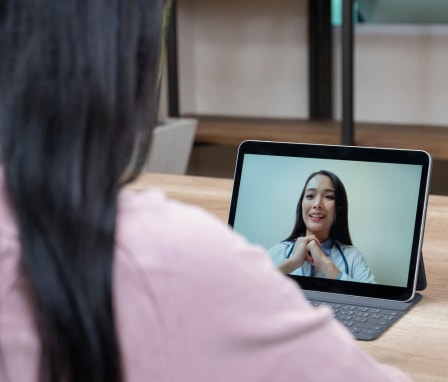What are the Pros and Cons of Telehealth Nursing?

Telehealth first gained traction when registered nurses began performing telephone triage, which involves advising and referring patient callers to the emergency room, an urgent care or specialty clinic, or their physician’s office. It’s a way for nurses to provide patients with access to long-distance healthcare through videoconferencing, streaming, and wireless communication.
With more people turning to telehealth during the pandemic, it’s likely that your career in nursing will involve aspects of telehealth. Continue reading for information about types of telenursing, the pros and cons of telehealth nursing, and additional learning resources.
Telehealth Nursing Pros and Cons: At a Glance
Pros
Convenient
Cost-saving
Efficient
Eliminates or Reduces Travel
Promotes Preventative Health
Cons
Technology Barriers
Insurance Coverage Issues
Regulatory Obstacles
Not Applicable in All Situations
Personal Barriers
What Is Telehealth Nursing?
The Telehealth Nursing Special Interest Group defines telehealth nursing as caring for patients remotely through a variety of audio or visual modalities.
Types of Telehealth
Common telehealth technologies include:
- Videoconferencing: Nurses and patients interact via video calls or live chat using a computer or smartphone. Examples include Doxy.me, Vidyo, VSEE, and Zoom.
- Remote Patient Monitoring: RPM technology allows remote patient health data recording. Nurses can access and monitor vital signs of patients with chronic conditions like asthma and diabetes.
- Mobile Health: mHealth consists of applications for smartphones, tablets, and smartwatches that continuously collect health data and integrate them into patients’ electronic health records.
- Store-and-Forward Telemedicine: This technology collects patient health data for cloud-based storage, which can be accessed by other health professionals remotely. Collected data includes biosignals, health records, intake interviews, x-rays, and ultrasounds.
Telehealth Nursing Pros
According to a 2021 National Institutes of Health (NIH) report, the advantages of telehealth nursing include cost-effectiveness, convenience, and efficiency.
Convenient
Anyone with a reliable internet or wireless connection can access telehealth at any time of day. Patients can avoid issues like traffic, parking, crowded waiting rooms, and having to leave work for doctor’s appointments. Nurses can work remotely and anyone concerned about or at high-risk for contracting diseases like COVID-19 can avoid potential transmission.
Cost-saving
Telehealth reaches patients without any added costs. Patients save money associated with transportation, parking, and missed work. Providers may spend less on office space and staff can work remotely, allowing patients to benefit from these cost-savings as well.
Efficient
Telehealth has streamlined many aspects of patient care, including reducing unnecessary visits to the emergency room, prolonged hospital stays, long appointment lead times, and patient wait times. Those with chronic conditions can benefit from frequent contact with a telehealth nurse.
Eliminates or Reduces Travel
Patients in underserved areas must often travel long distances to see their healthcare providers, and telehealth eliminates or reduces trips to the doctor’s office for them and also for those who are unable to travel.
Promotes Preventative Health
Patients and providers can use technology to track things like weight, blood sugar, and mental health concerns. Smartphone or tablet apps can make information more accessible and compliance with guidelines easier and more likely.
Telehealth Nursing Cons
The NIH report also describes some of the barriers to telehealth nursing.
Technology Barriers
Patients in rural and low-income areas, along with older adults, may not have access to reliable internet or wireless service, or computers and smartphones. Some members of the aging population may not have knowledge of or feel comfortable enough using the technology required to access telehealth. Data breaches are also an ongoing concern.
Insurance Coverage Issues
The insurance industry has not completely caught up with the rapid emergence of telehealth, which results in inconsistent coverage, rates, and patient reimbursements.
Regulatory Obstacles
States enact varying rules, regulations, and guidelines for healthcare, which may impose legal hurdles on telehealth. Nursing professionals without multi-state licenses may face barriers to their ability to deliver telehealth services.
Not Applicable in All Situations
Patients with certain medical conditions and injuries that necessitate physical examinations, hospital stays, or continuity of face-to-face care may not benefit from telehealth. Some states require an in-person visit or physical examination before prescribing medication.
Personal Barriers
Some patients distrust technology or feel resistant to using it for their care. Distrust of a remote visit with a nurse or other healthcare practitioner may drive the need to schedule in-person appointments.
Telehealth Nursing FAQs
In this section, we answer some of the most frequently asked questions about telenursing.
What is the difference between telehealth and telemedicine?
Telehealth encompasses a wide range of services delivered through the use of telecommunications in such healthcare areas as medical education, remote monitoring, videoconferencing consultations, and health data transmissions. Telemedicine falls under the umbrella of telehealth and specifically covers clinical services offered remotely.
What are the advantages of telehealth?
The advantages of telehealth nursing include convenient access any time of day or night, cost-savings for both patients and providers, and efficient care with shorter wait times. Telehealth nursing also eliminates or reduces the need to travel and promotes preventative health through tracking apps.
What is possibly the biggest disadvantage to telehealth?
The largest downside to telehealth may be inequitable access. People without reliable internet or wireless service and those who do not have a computer, tablet, or smartphone cannot participate in telehealth. Often those patients in underserved or remote areas who experience these types of barriers are the patient populations who need telehealth the most.
How do nurses benefit from telehealth?
Nurses deliver and coordinate frontline care, and telehealth helps them do their jobs more easily and effectively. Nurses can observe patients in their own surroundings and learn how their health is affected. Telehealth eases the nationwide nurse shortage by allowing nurses to see more patients. Telehealth also simplifies the process of meeting with patients and their caregivers and family members.
How Nurses Can Learn About Telehealth
Nurses can learn about telehealth and healthcare technology by pursuing an advanced degree, such as a master of science in nursing (MSN). Most schools offer MSN programs online, allowing nurses to continue working while they study.
Continuing education courses also cover technological topics and teach skills relevant to telehealth nursing. Courses can be taken online and some are offered free of charge.
In addition, organizations like the American Nurses Association and the American Academy of Ambulatory Care Nursing post information online and offer resources to nurses about telehealth.
Reviewed by:

Shri Deshaies is a nurse educator with over 20 years of experience teaching in hospital, nursing school, and community settings. Deshaies’ clinical area of expertise is critical care nursing and she is a certified critical care nurse. She has worked in various surgical ICUs throughout her career, including cardiovascular, trauma, and neurosurgery.
Shri Deshaies is a paid member of our Healthcare Review Partner Network. Learn more about our review partners here.


